Did you know Illinois is home to over 15 types of woodpeckers? This shows the amazing woodpecker variety in the state. Bird lovers have the chance to see many woodpecker types here, from common ones to rare kinds that like certain places.
Each type of woodpecker has its own look and job in Illinois’s nature. They are important for our environment. Whether you love bird watching or are just starting, learning about these birds will make you appreciate nature more. This guide gives you a closer look at Illinois’s woodpeckers, their actions, and where they live.
Key Takeaways
- Illinois is home to over 15 woodpecker species, providing diversity for bird enthusiasts.
- Woodpeckers in Illinois range from common generalists to rare species with specific habitat preferences.
- Each woodpecker type contributes uniquely to the state’s ecological balance.
- Understanding woodpecker varieties enhances bird watching and appreciation of Illinois’ natural habitats.
- This guide will help identify and learn about the behaviors and habitats of Illinois native woodpeckers.
Introduction to Illinois Woodpeckers
Illinois is a haven for many types of woodpeckers. This makes it a prime spot for bird watching. The state has forests and city areas that help woodpeckers thrive.
With its green forests and city neighborhoods, Illinois has many places for these birds. It’s great for both serious and casual bird watchers. You can see these amazing birds in their natural settings.
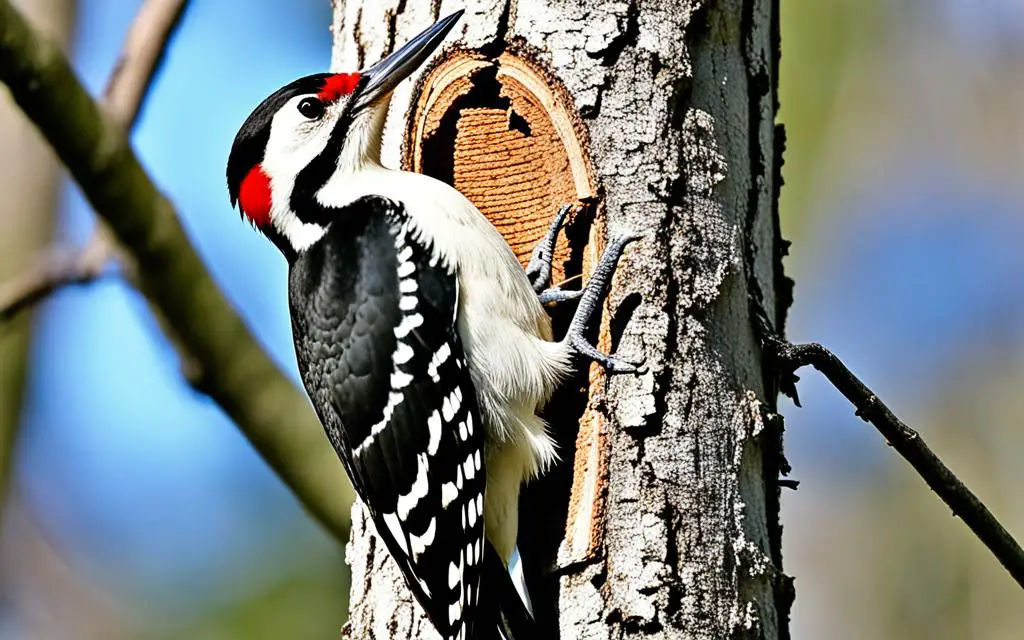
The story of Illinois woodpeckers is about how they adapt and survive. Types like the Downy Woodpecker, Red-bellied Woodpecker, and Pileated Woodpecker have their own roles. They add beauty to Illinois’ wildlife.
If you love bird watching, Illinois woodpeckers are a thrilling project. Learning about them shows us their importance in nature. It also helps us appreciate these special birds more.
Common Woodpecker Species Found in Illinois
Bird lovers in Illinois see many kinds of woodpeckers. Three species are especially common due to their unique looks and how often they’re seen.
Downy Woodpecker
The Downy Woodpecker is small but easy to spot. It has black and white plumage and a little red patch on its head. You can see it in woods and near homes, loving both nature and places where people live.
Hairy Woodpecker
The Hairy Woodpecker looks a lot like the Downy but is bigger. It also has black and white plumage and a big bill. You’ll find it in forests where the trees are old and tall.
Red-bellied Woodpecker
This bird has bright red markings on its head, making it easy to tell apart. It lives in many places, from thick woods to your backyard. It’s known for its red belly and loud calls.
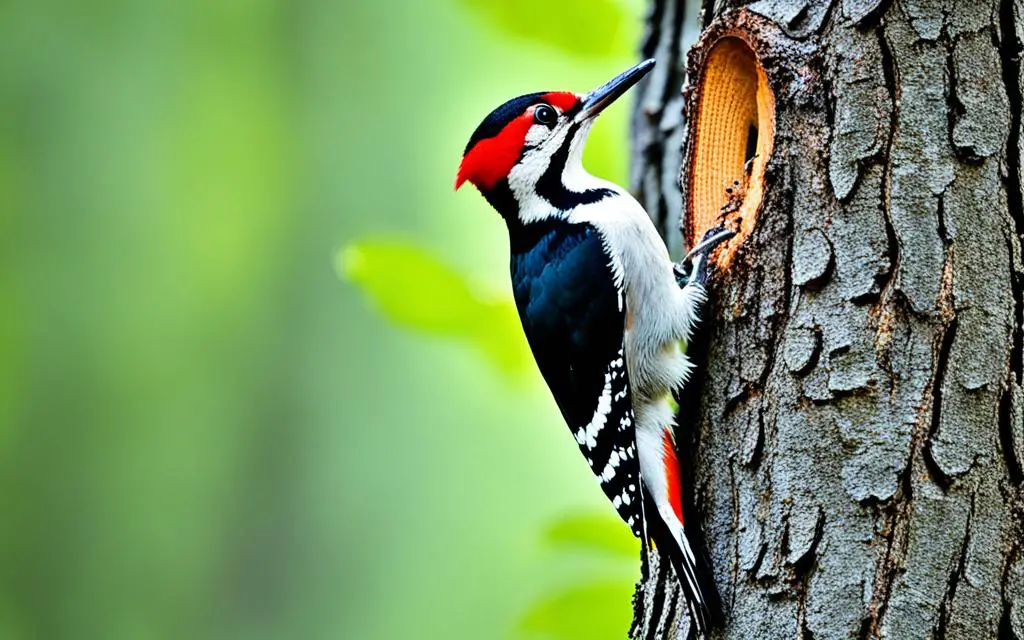
| Species | Size | Plumage | Habitat | Distinctive Feature |
|---|---|---|---|---|
| Downy Woodpecker | Small | Black and White | Woodlands, Suburban Areas | Small red patch on head |
| Hairy Woodpecker | Medium | Black and White | Forested Areas | Pronounced bill |
| Red-bellied Woodpecker | Medium | Muted with Red Markings | Woodlands, Suburban Areas | Red head and nape |
Seeing these woodpeckers is fun for people who love nature in Illinois. They offer a chance to watch interesting creatures that add color and life to both wild and city areas.
Rare Woodpecker Varieties in Illinois
Illinois is a home for many bird types. But, some woodpeckers are very special and rare. The Pileated Woodpecker and the Yellow-bellied Sapsucker stand out the most.
Pileated Woodpecker
The Pileated Woodpecker has a bright red crest and is rare in Illinois. It likes old forests to look for food in dead trees. Pileated Woodpecker identification is important for those who watch birds. Look for its red crest, big size, and unique call.
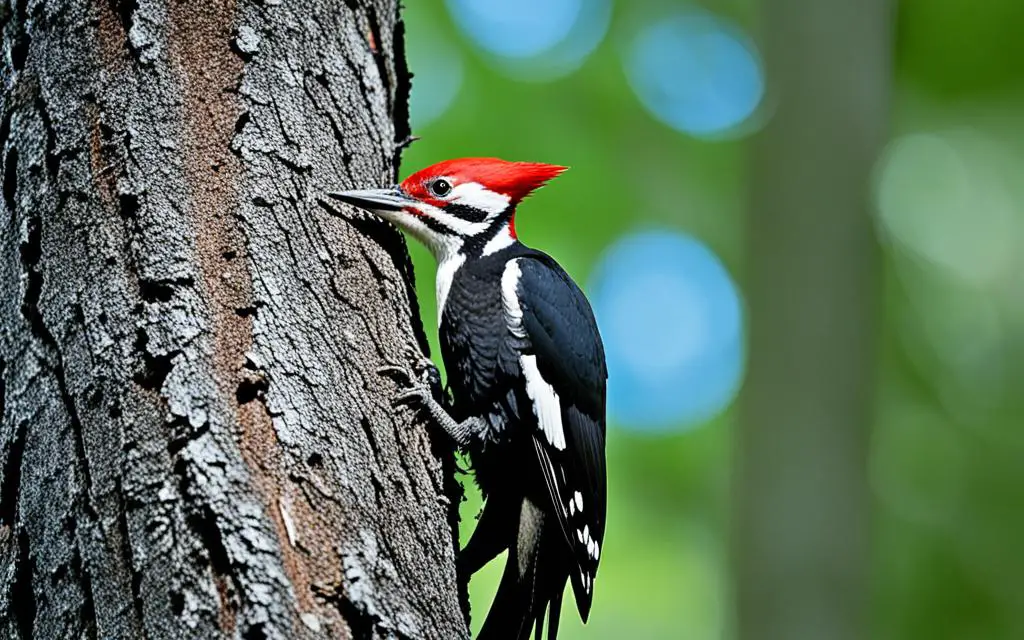
Yellow-bellied Sapsucker
The Yellow-bellied Sapsucker is another rare bird seen in Illinois at certain times. It’s known for making holes in trees to get sap. The Yellow-bellied Sapsucker habits are interesting. They eat the sap and bugs that come to it. These birds like young, living trees and are cool to see.
Woodpecker Habitats in Illinois
Woodpeckers in Illinois live in many places. They are in large forests and city areas too. These birds can adapt to different environments easily.
Forests and Woodlands
Woodpeckers love the deciduous trees in Illinois woodlands. These forests provide lots of food and places to live. Dead trees are important for them to make homes.
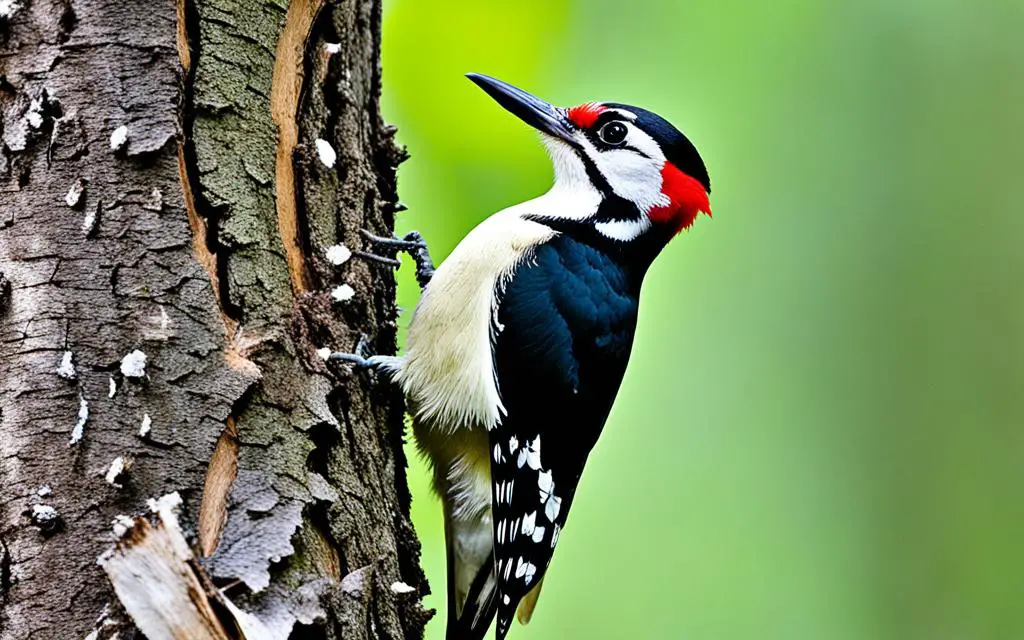
Urban and Suburban Areas
Woodpeckers also live happily in cities and suburbs. They make homes in tree cavities in parks and yards. They adapt well to these areas, finding food and nesting spots.
Feeding Habits and Diet
Woodpeckers in Illinois have diverse diets and feeding habits. This is due to the different foods available to them. These birds help the ecosystem by eating pests and spreading seeds.
Insect Eaters
A lot of the woodpecker diet in Illinois is made up of insects. These insect eaters use their sharp beaks to get beetles, ants, and more from under bark. Their pecking and drumming let them find these hidden snacks.
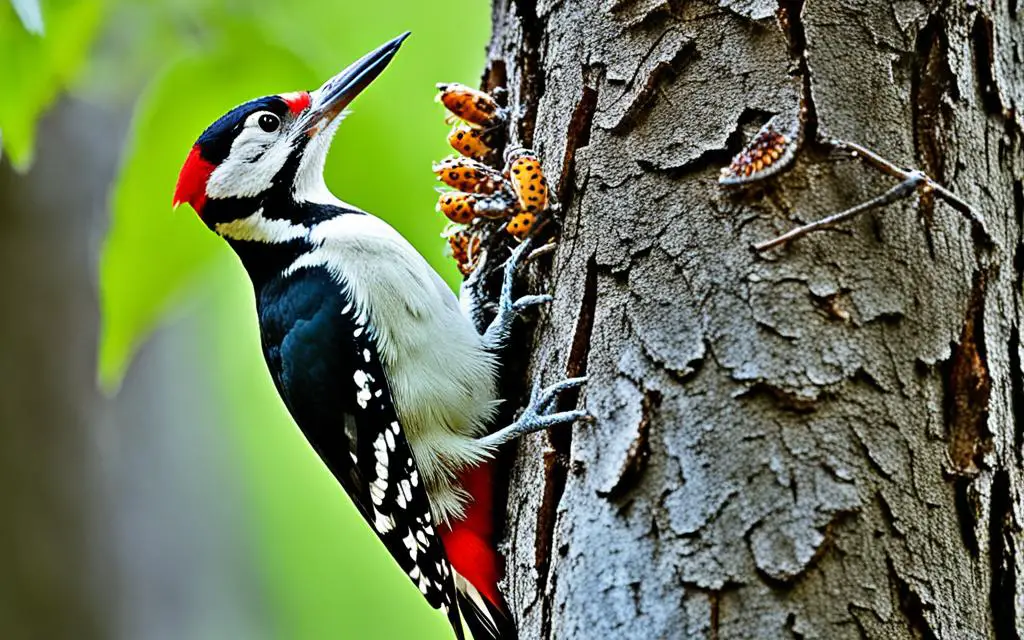
Other Food Sources
Woodpeckers don’t just eat insects. They also enjoy things like acorns and berries. In winter, they stash acorns in tree crevices. They also like eating fruits found in the wild.
Bird lovers can attract woodpeckers with suet, seeds, and chopped fruit. This extra food helps them especially when it’s cold out.
Woodpecker Behavior and Communication
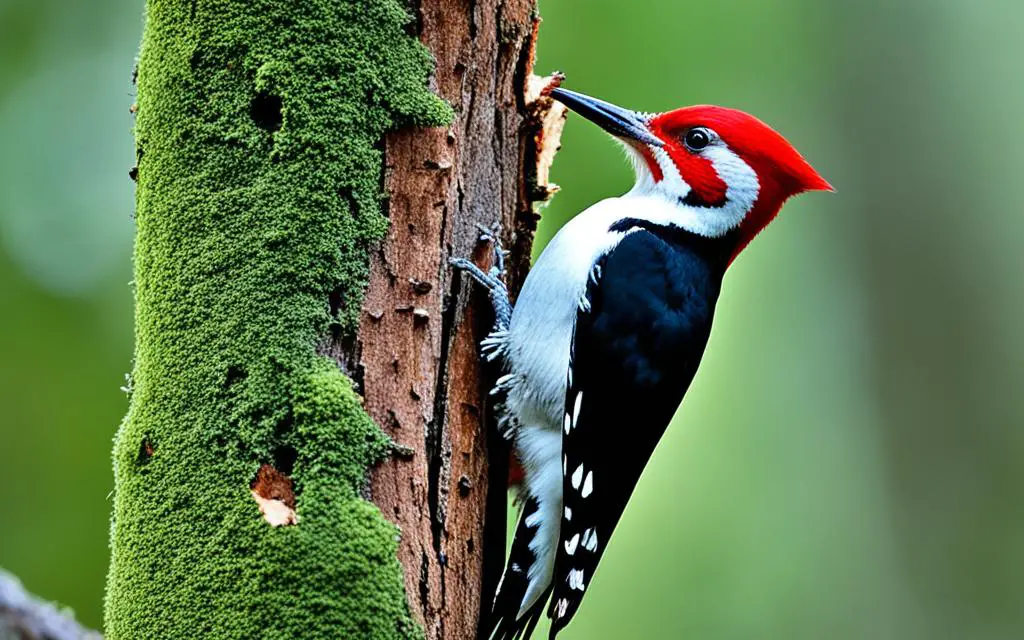
Woodpeckers in Illinois show interesting behaviors and ways of talking. These include drumming and special calls. They help us understand how woodpeckers interact with each other.
Drumming
Drumming is a key behavior of Illinois woodpeckers. They peck quickly on things that make sound. This helps them find mates, mark their area, and talk to others. Each kind of woodpecker has its own drumming style. This helps bird watchers tell them apart by their drum patterns.
Woodpecker Calls
Woodpecker calls are very different from one to another. Some sounds are short and sharp, while others are like songs. These calls do many things. They warn of danger, help woodpeckers stay together, and keep them close as friends. Their unique calls and striped backs make it easy to know who they are.
Looking into how woodpeckers in Illinois behave teaches us a lot. Their drumming and calling show the complex ways they live together. It shows us how these actions are vital for them.
Conservation Efforts for Illinois Woodpeckers
Illinois works hard to help its woodpecker populations. These efforts aim to keep woodpeckers safe and their communities healthy.
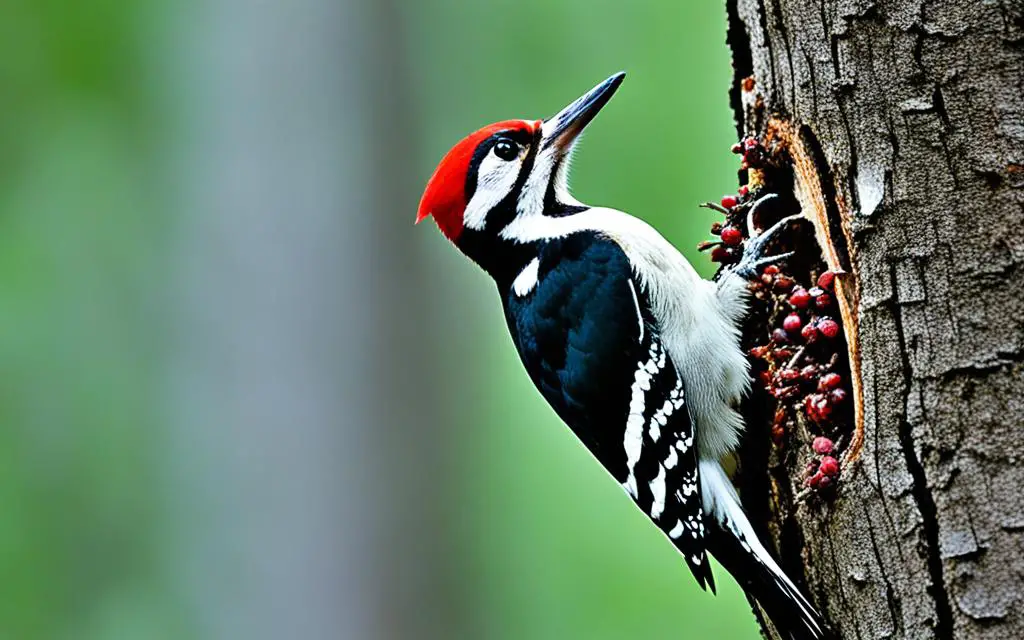
Habitat Preservation
Illinois focuses on saving the natural homes of woodpeckers. They protect forests where woodpeckers find food and places to live. Dead tree preservation is also key, as these trees are vital for nesting.
Nest Box Programs
Nest box programs are another big part of their work. These boxes offer new homes when natural spots are rare. Putting nest boxes in the right places helps woodpeckers raise their families safely.
| Conservation Efforts | Benefits |
|---|---|
| Habitat Preservation | Maintains natural habitats, supports foraging and nesting, promotes dead tree preservation |
| Nest Box Programs | Provides alternative nesting sites, enhances bird community health, supports young woodpeckers |
All these actions are vital for Illinois woodpeckers. The state is pushing forward with these plans. This helps the bird community thrive and keeps woodpeckers around for a long time.
Breeding and Nesting Behaviors
During the woodpecker breeding season Illinois, these amazing birds show special behaviors. They do this to make sure their young survive. The action starts with digging out nests in trees. This is called nest excavation.
This tree cavity nesting is not just safe for the birds. It also keeps the forest healthy. It does this by helping trees break down and recycle nutrients.
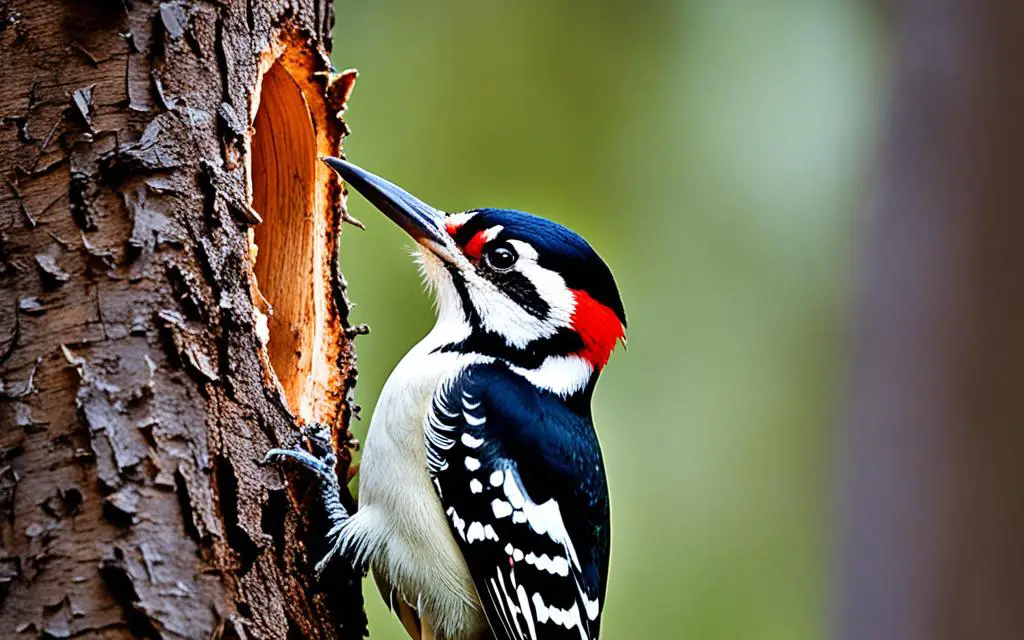
Woodpeckers are great at taking care of their babies. Both mom and dad woodpeckers help keep the eggs warm. They also feed their babies. This team work is key for the little ones to grow strong.
The woodpecker breeding season Illinois happens when there’s lots of food. This means there’s enough food for the baby birds.
Understanding breeding and nesting behaviors teaches us a lot. It shows how woodpeckers fit into their homes. Here’s a closer look at what they do:
| Stage | Description |
|---|---|
| Breeding Season | Occurs in early spring, lasting through summer, aligning with peak food availability. |
| Nest Excavation | Both sexes participate in carving out tree cavities, primarily in dead or decaying trees. |
| Tree Cavity Nesting | Provides a safe, enclosed space for eggs and hatchlings, protecting them from predators. |
| Parental Care | Both parents share duties of incubation and feeding, ensuring optimal chick development. |
Woodpecker Types Illinois
The Illinois landscape is rich with different woodpecker types. Both resident woodpeckers Illinois and migratory kinds add to the state’s diversity. Year-round locals like the Downy and Hairy Woodpeckers are key to the ecosystem. Migratory woodpeckers like the Yellow-bellied Sapsucker add seasonal variety.
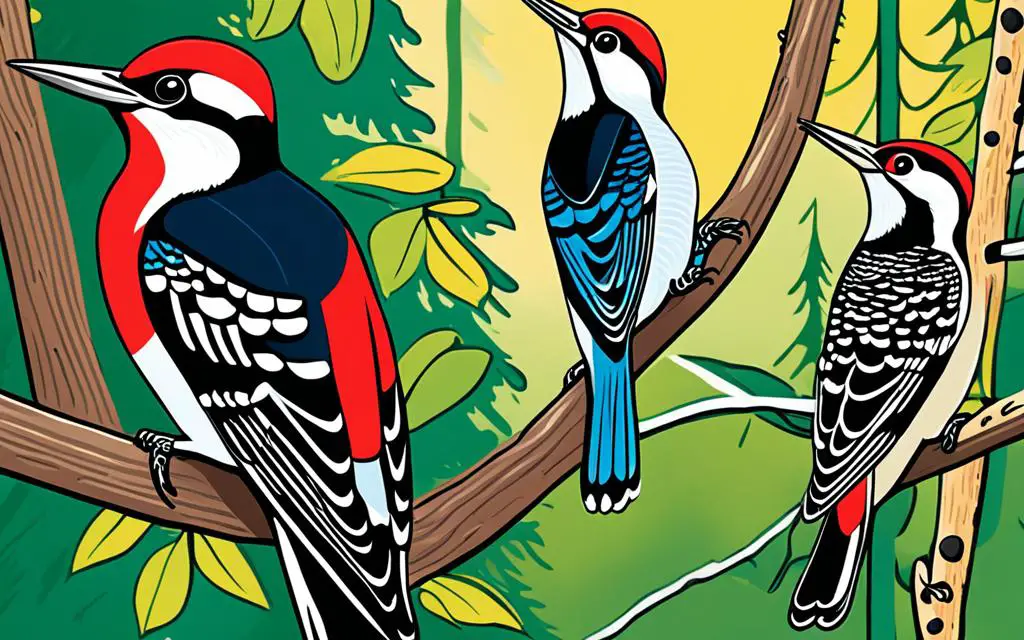
Detailed range maps help us track these birds’ movements. They’re great for birdwatchers and researchers. The maps show where year-round residents and migratory species meet. They also show what influences their living spaces.
The variety of species in Illinois shows the area’s diverse habitats. Forests, urban, and suburban areas help support both permanent and seasonal woodpeckers.
Impact of Urbanization on Woodpecker Populations
Urban areas are growing in Illinois, affecting woodpecker homes. These birds once lived in large forests but now deal with changes from cities and parks. This brings both new challenges and chances for them.
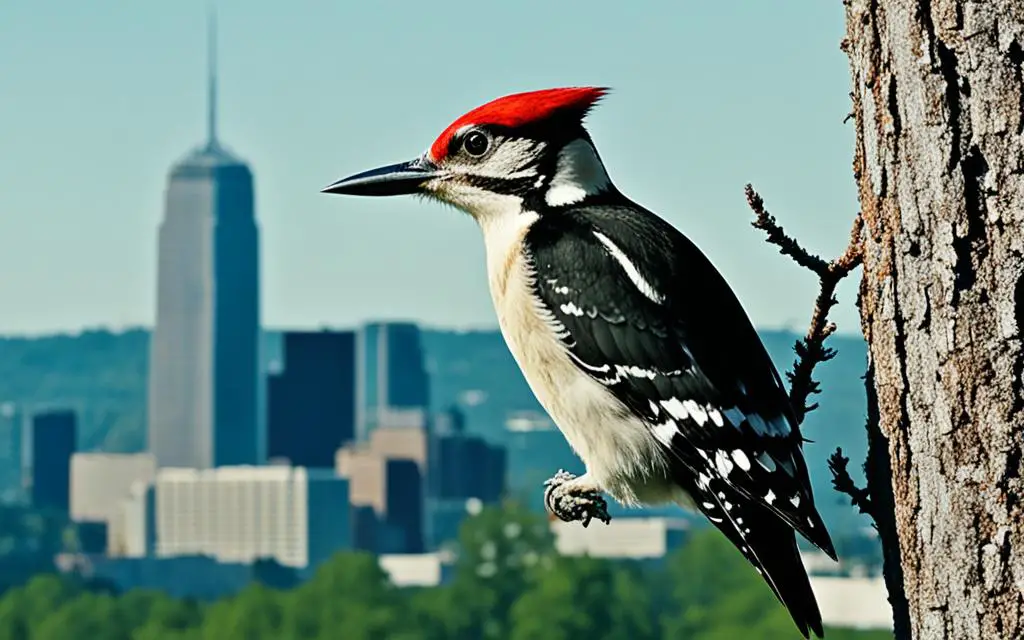
Urban Development
City building breaks up bird homes, making it hard for woodpeckers to find food and nests. Turning forests into buildings and streets means less dead wood and fewer big trees. These are important for woodpeckers to live and find food.
This loss of homes affects them, especially those needing big, old trees.
- Loss of nesting sites due to tree removal.
- Reduction in insect populations, which are a primary food source.
- Increased competition with other urban bird species.
Conservation Efforts in Urban Areas
Even with these urban challenges, there are efforts to help woodpeckers in cities. In Illinois, saving and managing parks helps a lot. City planners are trying to keep good homes for city woodpeckers. They do this by:
- Planting native trees that provide natural food sources and nesting opportunities.
- Establishing nest box programs to offer alternative nesting sites in areas where natural cavities are scarce.
- Protecting existing green spaces and preserving mature trees to maintain essential habitats for these birds.
Fighting urban issues with careful city conservation can help. It might lessen the bad impacts and keep woodpeckers happy in Illinois.
To really understand, we should compare city building to city conservation:
| Aspect | Urban Development | Conservation Efforts |
|---|---|---|
| Habitat Availability | Decreased | Increased through green space management |
| Nesting Sites | Limited | Enhanced with nest box programs |
| Food Sources | Reduced insect populations | Native tree planting |
| Ecosystem Support | Fragmented | Integrated and preserved |
Conclusion
Exploring Illinois’ woodpeckers shows the state’s rich nature. The Downy and Hairy Woodpeckers are common. But the Pileated Woodpecker and Yellow-bellied Sapsucker are rarer. Each bird is unique to the ecosystem.
They show the adaptability of Illinois’ nature. This tells us why we must keep their homes safe.
Woodpeckers mean healthy ecosystems. They give us important info about their homes. So, saving woodpeckers helps Illinois’ nature overall.
Efforts to save their homes are key. This includes keeping natural areas safe and using nest boxes. This way, we and future folks can enjoy these birds.
Woodpeckers show us how healthy our earth is. Keeping them safe helps keep nature in balance. By doing this, we support all life in Illinois.
Working on conservation, green spaces, and teaching people are important. These efforts help keep our feathered friends and nature thriving.
FAQ
What types of woodpeckers can be found in Illinois?
How can I identify common woodpecker species in Illinois?
What woodpeckers are considered rare in Illinois?
Where do woodpeckers in Illinois typically live?
What do woodpeckers eat in Illinois?
How do woodpeckers communicate?
What conservation efforts are in place for woodpeckers in Illinois?
When do woodpeckers in Illinois breed and nest?
Are there resident and migratory woodpeckers in Illinois?
How has urbanization affected woodpecker populations in Illinois?
Source Links
- https://www.pinterest.com/pin/7-different-species-of-woodpeckers-in-illinois-w-pictures–620722761156005375/
- https://abcbirds.blog/woodpeckers-in-illinois/
- https://news.illinois.edu/view/6367/1579203740

My name is Shane Warren, the author behind Your Bird Buddy – your ultimate guide to the wonderful world of birds! Unleash your inner avian explorer as we delve into a vibrant library of knowledge dedicated to all things feathered. From learning about diverse bird species from across the globe to understanding their captivating habitats and behaviors, I’m here to fuel your passion for these magnificent creatures. Not only that, but I also provide valuable insights on being a responsible and informed pet bird owner. Join our vibrant community and let’s celebrate the feathered wonders of the world together – one chirp at a time. And be sure to join our Your Bird Buddy Community over on Facebook!

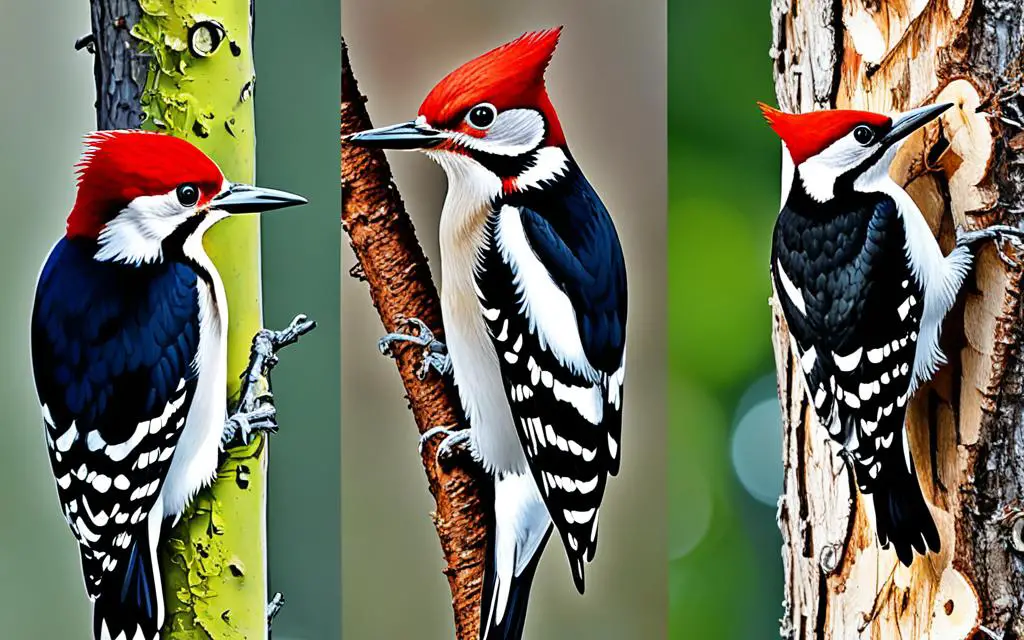
Comments are closed